Spatiotemporal Heterogeneity of the Characteristics and Influencing Factors of Energy-Consumption-Related Carbon Emissions in Jiangsu Province Based on DMSP-OLS and NPP-VIIRS
Abstract
:1. Introduction
2. Data and Methods
2.1. Study Area
2.2. Data
2.2.1. Night-Time Light Data
2.2.2. Statistical Data
2.3. Methods
2.3.1. Energy Consumption Carbon-Emission Calculation Model
2.3.2. Simulating Carbon Emissions Based on Night-Time Lighting Data
2.3.3. GTWR Model
3. Results
3.1. The Spatiotemporal Evolution Characteristics of Carbon Emissions
3.1.1. Provincial Scales
3.1.2. Municipal Scale
3.1.3. County Scales
3.2. Analysis of Factors Affecting Carbon Emissions
3.2.1. Empirical Results of GTWR
3.2.2. Spatial and Temporal Heterogeneity of Factors Affecting Carbon Emissions
4. Discussion
4.1. The Spatiotemporal Evolution Characteristics of Carbon Emissions
4.2. Analysis of Factors Affecting Carbon Emissions
4.3. Implications
5. Conclusions
- (1)
- In this paper, DMSP-OLS and NPP-VIIRS global night-light data from 2000 to 2013 and from 2012 to 2019 were corrected. On the basis of these two data sources, images from 2012 to 2013 were fused and corrected, and the goodness of fit was 0.894. Finally, a long time series night-light dataset for Jiangsu Province from 2000 to 2019 was obtained. According to the statistical value of carbon emissions from energy consumption in Jiangsu Province, a carbon-emission estimation model was constructed. The phased estimation results showed that the goodness of fit of the models reached more than 0.99 with an average relative error of 7.71%, which met the estimation accuracy requirements.
- (2)
- During the research period, the total carbon emissions from energy consumption in Jiangsu Province continued to grow, with a growth rate showing a “slow acceleration deceleration” upward trend. Spatially, there was a trend of expanding from point distribution to block-like continuous expansion, ultimately forming several high-density emission clusters centered around various urban areas. Overall, there was an uneven distribution pattern of “low in the north and high in the south”. Suzhou, Nanjing, Wuxi, Nantong, and other key cities had high carbon emissions.
- (3)
- In general, population size, energy intensity, and the economic level have been the core driving factors affecting carbon emissions in Jiangsu Province in the past 20 years. The impact of population size and energy intensity is on the rise, while the driving force of economic level is on the decline. Meanwhile, urbanization rate, industrial structure, and foreign investment have weak explanatory power regarding carbon emissions. Comparatively speaking, carbon emissions in central and southern Jiangsu are more strongly affected by population, economy, energy intensity, and other factors than in northern Jiangsu, where economic development is lagging slightly behind. Meanwhile, carbon emissions in northern Jiangsu are more strongly affected by the industrial structure, the urbanization rate, and other factors than those in southern Jiangsu, but the impact of population and the economy on carbon emissions in northern Jiangsu has also gradually increased since 2000.
Author Contributions
Funding
Data Availability Statement
Conflicts of Interest
References
- Shi, G.; Yan, H.; Zhang, W.; Dodson, J.; Heijnis, H.; Burrows, M. Rapid warming has resulted in more wildfires in northeastern Australia. Sci. Total Environ. 2021, 771, 144888. [Google Scholar] [CrossRef]
- Valone, T.F. Linear Global Temperature Correlation to Carbon Dioxide Level, Sea Level, and Innovative Solutions to a Projected 6 °C Warming by 2100. J. Geosci. Environ. Prot. 2021, 9, 84–135. [Google Scholar] [CrossRef]
- Weitzman, M.L. Book Review—A Review of William Nordhaus’ the Climate Casino: Risk, Uncertainty, and Economics for a Warming World. Rev. Environ. Econ. Policy 2015, 9, 145–156. [Google Scholar] [CrossRef]
- Nepal, R.; Paija, N. A multivariate time series analysis of energy consumption, real output and pollutant emissions in a developing economy: New evidence from Nepal. Econ. Model. 2019, 77, 164–173. [Google Scholar] [CrossRef]
- Qian, Y.; Zhao, J.; Lyu, Y.; Liu, Y.; Tian, J.; Chen, L. Uncovering the roadmap of decoupling economic growth and CO2 emissions targeting energy-resource-emission-intensive industrial parks located nearby large river: Practices and implications from China. J. Clean. Prod. 2023, 393, 136306. [Google Scholar] [CrossRef]
- Wang, S.; Liu, Y.; Fang, C. Review of energy-related CO2 emission in response to climate change. Prog. Geogr. 2015, 34, 151–164. [Google Scholar]
- Wang, W.; Liu, L.; Liao, H.; Wei, Y. The impact of urbanization on carbon emissions: Analysis of panel data from 158 cities in China. Acta Ecol. Sin. 2020, 40, 7897–7907. [Google Scholar]
- Li, X.; Zhang, Q. Factors affecting carbon emission from energy consumption in Tianjin. Arid Zone Res. 2019, 36, 997–1004. [Google Scholar]
- Zhang, Y.; Pan, J. Spatio-temporal simulation and differentiation pattern of carbon emissions in China based on DMSP/OLS nighttime light Data. China Environ. Sci. 2019, 39, 1436–1446. [Google Scholar]
- Chao, J.; Zhao, X.; Li, T.; Qing, Y. Comparative analysis on the dynamic characteristics of scale structure among three urban agglomerations in the Yangtze River Economic Belt based on multi-source nighttime light data. Geogr. Geo-Inf. Sci. 2020, 36, 44–51. [Google Scholar]
- Lv, Q.; Liu, H.; Wang, J.; Liu, H.; Shang, Y. Multiscale analysis on spatiotemporal dynamics of energy consumption CO2 emissions in China: Utilizing the integrated of DMSP-OLS and NPP-VIIRS nighttime light datasets. Sci. Total Environ. 2020, 703, 134394. [Google Scholar] [CrossRef] [PubMed]
- Welch, R. Monitoring urban population and energy utilization patterns from satellite Data. Remote Sens. Environ. 1980, 9, 1–9. [Google Scholar] [CrossRef]
- Elvidge, C.; Zhizhin, M.; Ghosh, T.; Hsu, F.; Taneja, J. Annual time series of global VIIRS nighttime lights derived from monthly averages: 2012 to 2019. Remote Sens. 2021, 13, 922. [Google Scholar] [CrossRef]
- Chen, J.; Gao, M.; Cheng, S.; Liu, X.; Hou, W.; Song, M.; Li, D.; Fan, W. China’s city-level carbon emissions during 1992–2017 based on the inter-calibration of nighttime light data. Sci. Rep. 2021, 11, 3323. [Google Scholar] [CrossRef] [PubMed]
- Xu, G.; Cai, Z.; Feng, S. Spatial and temporal differences and influencing factors of carbon emissions based on the analysis of the two-stage LMDI model—An empirical study on Jiangsu Province. Soft Sci. 2021, 35, 107–113. [Google Scholar]
- Dong, K.; Jiang, H.; Sun, R.; Dong, X. Driving forces and mitigation potential of global CO2 emissions from 1980 through 2030: Evidence from countries with different income levels. Sci. Total Environ. 2019, 649, 335–343. [Google Scholar] [CrossRef] [PubMed]
- Zhao, J.; Ji, G.; Yue, Y.; Lai, Z.; Chen, Y.; Yang, D.; Yang, X.; Wang, Z. Spatio-temporal dynamics of urban residential CO2 emissions and their driving forces in China using the integrated two nighttime light datasets. Appl. Energy 2019, 235, 612–624. [Google Scholar] [CrossRef]
- Lv, T.; Zeng, C.; Liu, Z.; Yang, J. Driving factors and spillover effects of CO2 emissions from the perspective of spatial interaction: A case study of 98 countries worldwide. Acta Ecol. Sin. 2020, 40, 8974–8987. [Google Scholar]
- Du, H.; Wei, W.; Zhang, X.; Ji, X. Spatio-temporal evolution and influencing factors of energy-related carbon emissions in the Yellow River Basin: Based on the DMSP/OLS and NPP/VIIRS nighttime light data. Geogr. Res. 2021, 40, 2051–2065. [Google Scholar]
- Lian, Y. Economic hierarchy and environmental pollution: An environmental Kuznets curve study based on carbon emissions. Stat. Decis. 2021, 37, 146–150. [Google Scholar]
- Wang, K.; Tang, X.; Gan, C.; Liu, H. Temporal-spatial evolution and influencing factors of carbon emission intensity of China’s service industry, China Population. Res. Environ. 2021, 31, 23–31. [Google Scholar]
- Raupach, M.; Rayner, P.; Paget, M. Regional variations in spatial structure of nightlights, population density and fossil-fuel CO2 emissions. Energy Policy 2010, 38, 4756–4764. [Google Scholar] [CrossRef]
- Shi, K.; Chen, Y.; Yu, B.; Xu, T.; Chen, Z.; Liu, R.; Li, L.; Wu, J. Modeling spatiotemporal CO2 (carbon dioxide) emission dynamics in China from DMSP-OLS nighttime stable light data using panel data analysis. Appl. Energy 2016, 168, 523–533. [Google Scholar] [CrossRef]
- Su, Y.; Chen, X.; Li, Y.; Liao, J.; Ye, Y.; Zhang, H.; Huang, N.; Kuang, Y. China’s 19-year city-level carbon emissions of energy consumptions, driving forces and regionalized mitigation guidelines. Renew. Sustain. Energy Rev. 2014, 35, 231–243. [Google Scholar] [CrossRef]
- Meng, L.; Graus, W.; Worrell, E.; Huang, B. Estimating CO2 (carbon dioxide) emissions at urban scales by DMSP/OLS (Defense Meteorological Satellite Program’s Operational Linescan System) nighttime light imagery: Methodological challenges and a case study for China. Energy 2014, 71, 468–478. [Google Scholar] [CrossRef]
- Hu, Y.; Qiao, W.; Wan, Y.; He, T.; Chai, Y.; Bi, Y. Comprehensive evaluation and spatial distinction of land use efficiency in county area of Jiangsu Province. Econ. Geogr. 2020, 40, 186–195. [Google Scholar]
- Qiao, X.; Gu, Y.; Zhou, C.; Huang, X.; Hu, T. The impact of urban expansion on net primary productivity in the Taihu Lake basin based on nighttime light images. Acta Ecol. Sin. 2018, 38, 5883–5893. [Google Scholar]
- Lv, Q.; Liu, H. Multiscale spatio-temporal characteristics of carbon emission of energy consumption in Yellow River Basin based on the nighttime light datasets. Econ. Geogr. 2020, 40, 12–21. [Google Scholar]
- Wu, K.; Wang, X. Aligning pixel values of DMSP and VIIRS nighttime light images to evaluate urban dynamics. Remote Sens. 2019, 11, 1463. [Google Scholar] [CrossRef] [Green Version]
- Shi, K.; Yu, B.; Huang, Y.; Hu, Y.; Yin, B.; Chen, Z.; Chen, L.; Wu, J. Evaluating the ability of NPP-VIIRS nighttime light data to estimate the gross domestic product and the electric power consumption of China at multiple scales: A comparison with DMSP-OLS data. Remote Sens. 2014, 6, 1705–1724. [Google Scholar] [CrossRef] [Green Version]
- Su, Y.; Chen, X.; Ye, Y.; Wu, Q.; Zhang, H.; Huang, N.; Kuang, Y. The characteristics and mechanisms of carbon emissions from energy consumption in China using DMSP/OLS night light imageries. Acta Geogr. Sin. 2013, 68, 1513–1526. [Google Scholar]
- Henriques, S.; Borowiecki, K. The drivers of long-run CO2 emissions in Europe, North America and Japan since 1800. Energy Policy 2017, 101, 537–549. [Google Scholar] [CrossRef]
- González, P.; Landajo, M.; Presno, M. The driving forces behind changes in CO2 emission levels in EU-27. Differences between member states. Environ. Sci. Policy 2014, 38, 11–16. [Google Scholar] [CrossRef]
- Liu, X.; Ning, X.; Wang, H.; Wang, C.; Zhang, H.; Meng, J. A rapid and automated urban boundary extraction method based on nighttime light data in China. Remote Sens. 2019, 11, 1109–1126. [Google Scholar] [CrossRef] [Green Version]
- Pan, J.; Li, J. Spatiotemporal dynamics of electricity consumption in China. Appl. Spat. Anal. Policy 2019, 12, 395–422. [Google Scholar] [CrossRef]
- Wang, L.; Zhang, N.; Deng, H.; Wang, P.; Yang, F.; Qu, J.; Zhou, X. Monitoring urban carbon emissions from energy consumption over China with DMSP/OLS nighttime light observations. Theor. Appl. Climatol. 2022, 149, 983–992. [Google Scholar] [CrossRef]
- Liu, Q.; Wu, R.; Zhang, W.; Li, W.; Wang, S. The varying driving forces of PM2. 5 concentrations in Chinese cities: Insights from a geographically and temporally weighted regression model. Environ. Int. 2020, 145, 106168. [Google Scholar] [CrossRef]
- Huang, H.; Zhu, N. Study on Spatiotemporal Characteristics of the Impacting Factors of Agricultural Carbon Emissions Based on the GTWR Model: Evidence from the Yellow River Basin, China. Nat. Environ. Pollut. Technol. 2022, 21, 607–615. [Google Scholar] [CrossRef]
- Shen, Y.; Wang, C.; Gao, C.; Ding, L. Spatio-temporal distribution and its influencing factors of carbon emissions in economic zone of Zhejiang Bay Area based on urbanization. J. Nat. Res. 2020, 35, 329–342. [Google Scholar]
- Huang, B.; Wu, B.; Barry, M. Geographically and temporally weighted regression for modeling spatio-temporal variation in house prices. Int. J. Geogr. Inf. Sci. 2010, 24, 383–401. [Google Scholar] [CrossRef]
- Dai, Y.; Chen, X.; Wang, M. Research on kuznets effect of carbon emission: Taking Jiangsu Province as an example. Stat. Decis. 2020, 36, 75–78. [Google Scholar]
- Wang, S.; Xie, Z.; Wang, Z. The spatiotemporal pattern evolution and influencing factors of CO2 emissions at the county level of China. Acta Geogr. Sin. 2021, 76, 3103–3118. [Google Scholar]
- Mala, P.; Palanivel, M.; Priyan, S.; Jirawattanapanit, A.; Rajchakit, G.; Kaewmesri, P. Sustainable supply chain system for defective products with different carbon emission strategies. Sustainability 2022, 14, 16082. [Google Scholar] [CrossRef]
- Li, J.; Huang, X.; Chuai, X.; Sun, S. Spatio-temporal characteristics and influencing factors of carbon emissions efficiency in the Yangtze River Delta region. Resour. Environ. Yangtze Basin 2020, 29, 1486–1496. [Google Scholar]
- Cui, Y.; Zha, H.; Jiang, L.; Zhang, M.; Shi, K. Luojia 1-01 Data Outperform Suomi-NPP VIIRS Data in Estimating CO2 Emissions in the Service, Industrial, and Urban Residential Sectors. IEEE Geosci. Remote Sens. 2023, 25, 3000905. [Google Scholar] [CrossRef]

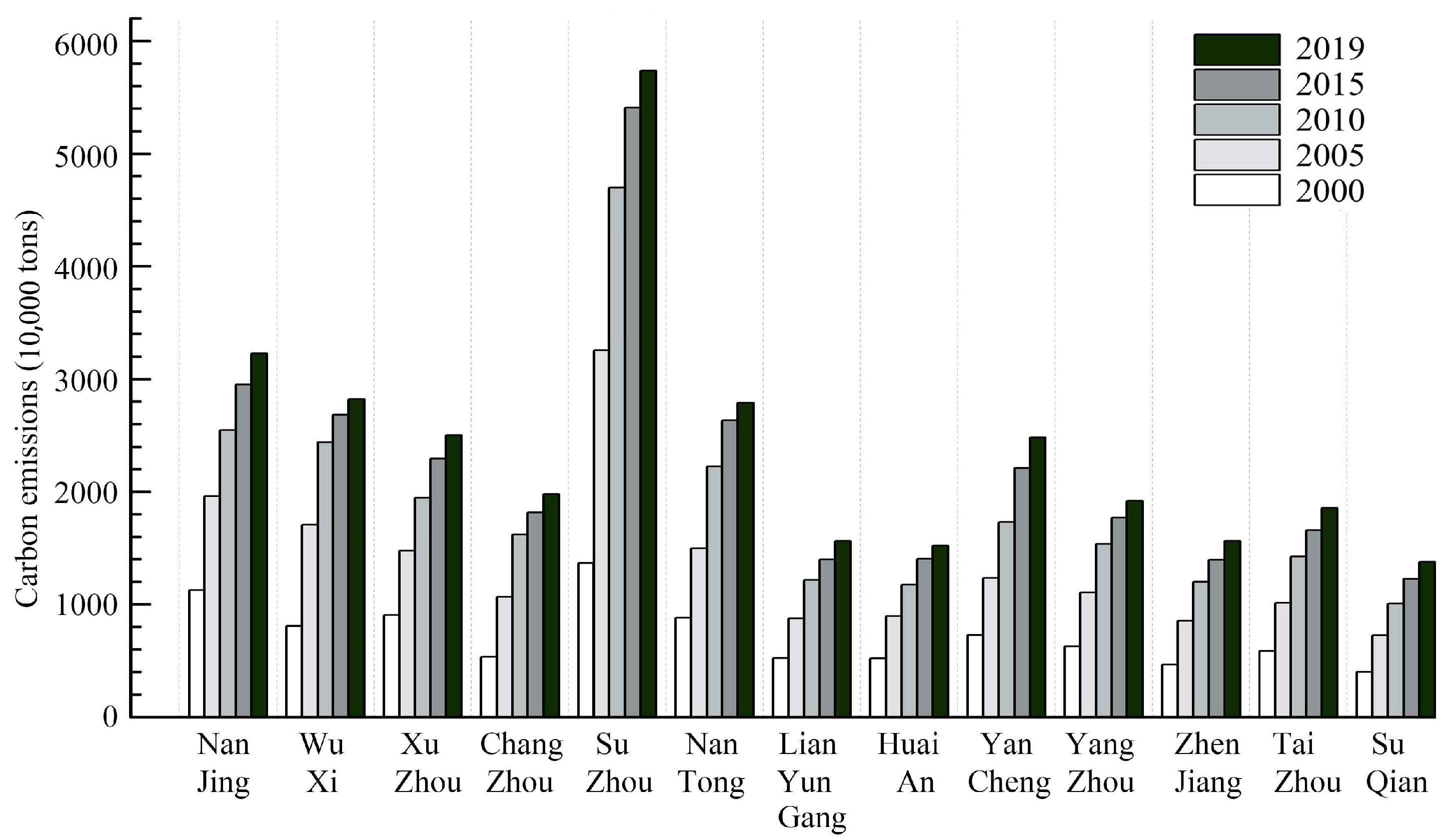

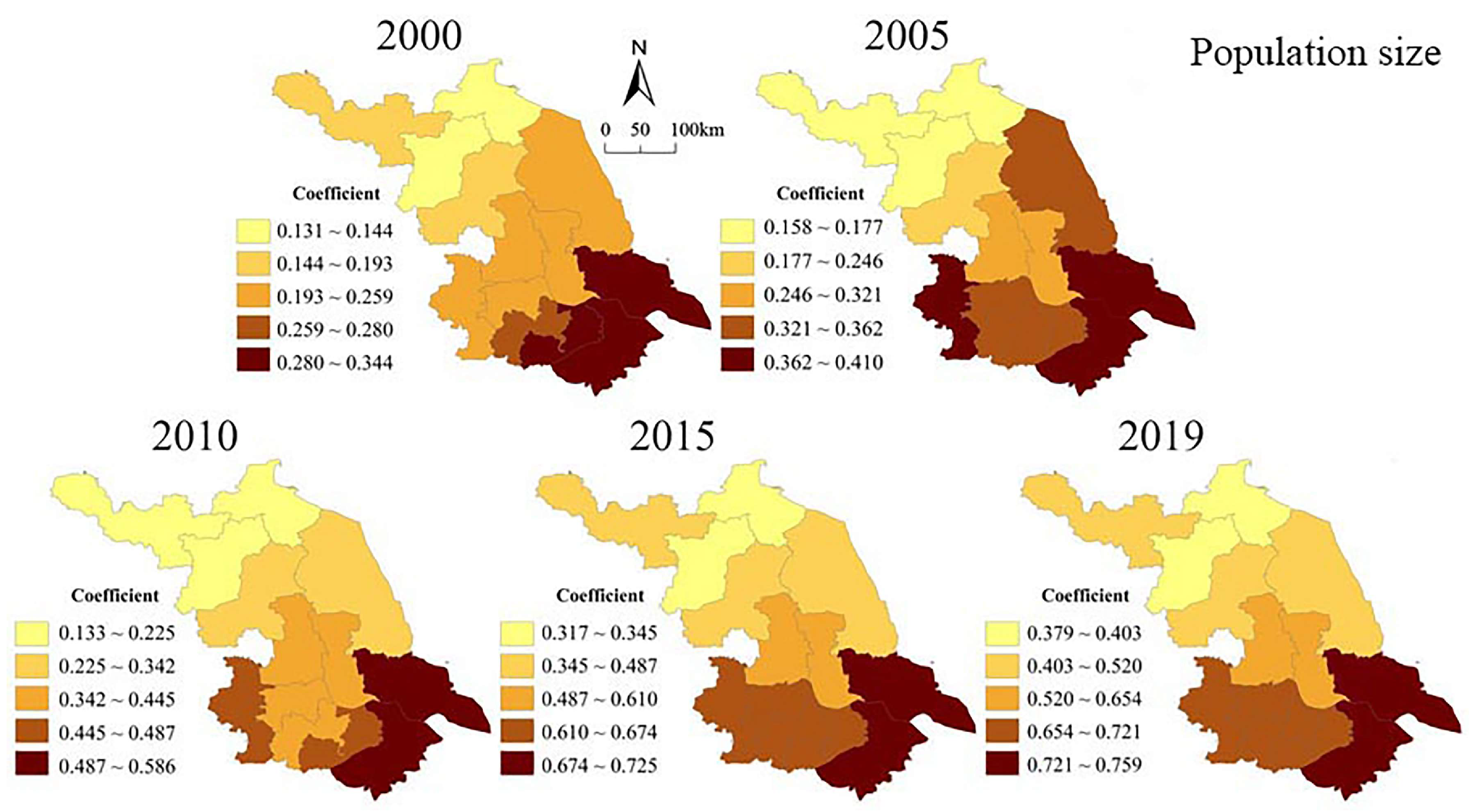
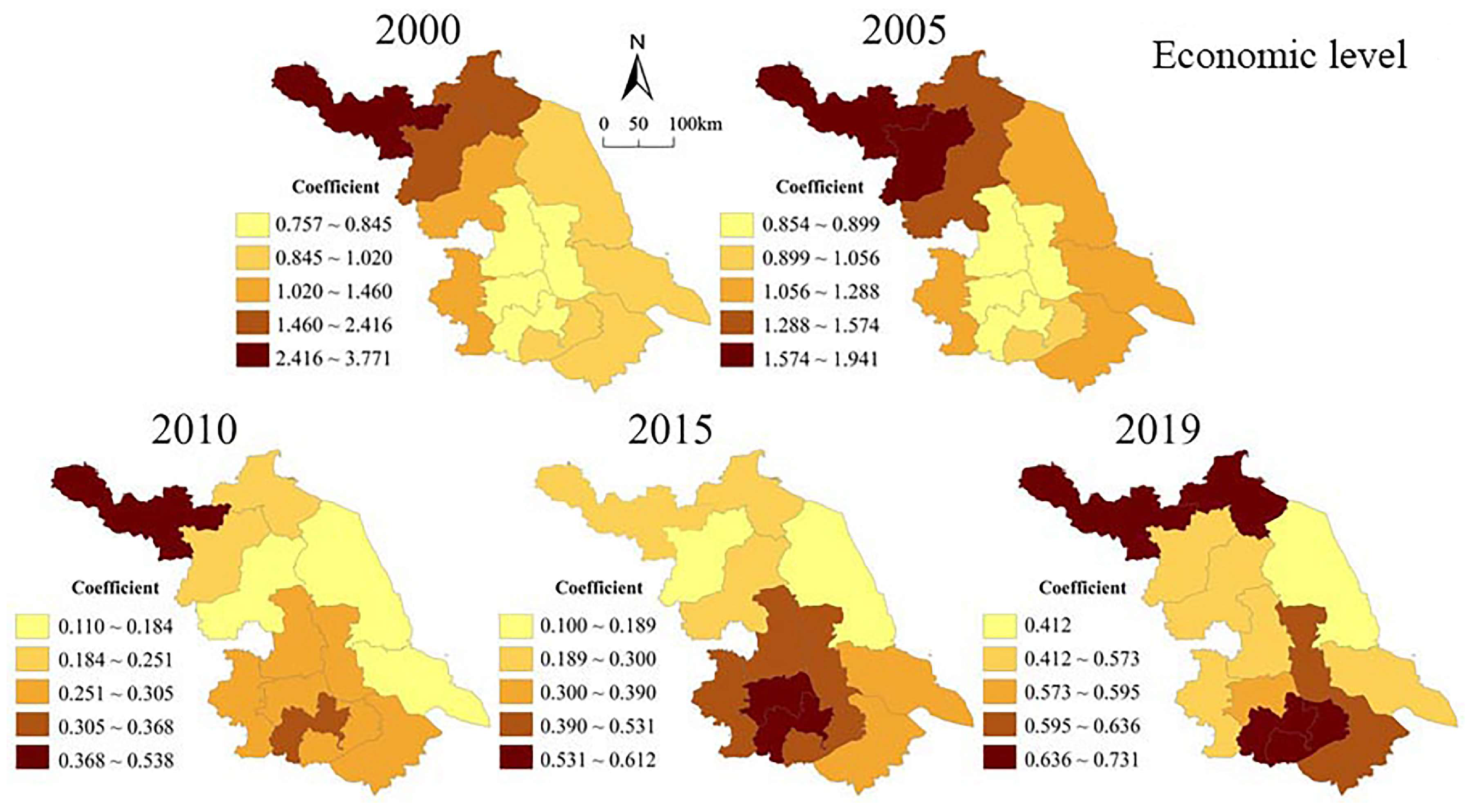
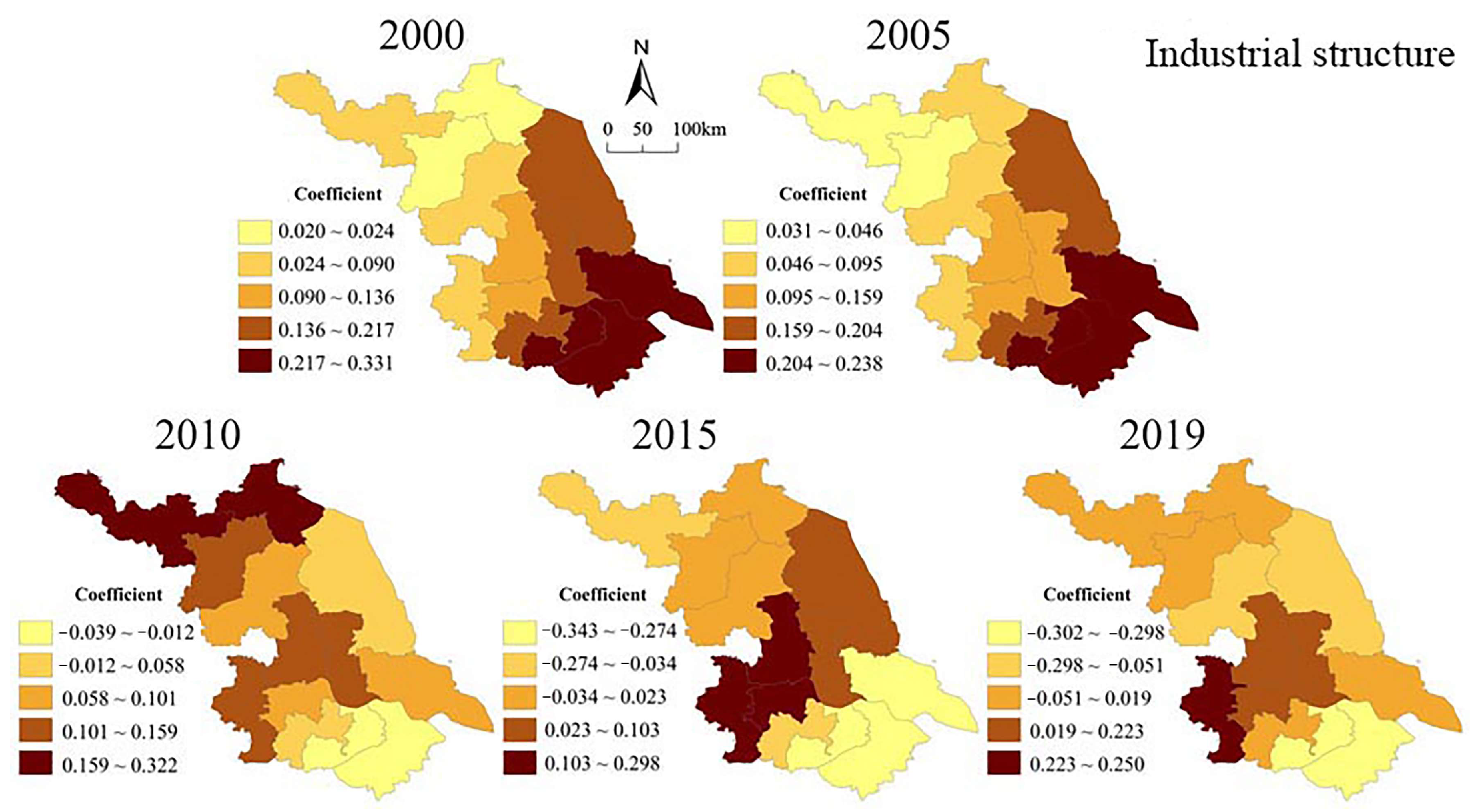
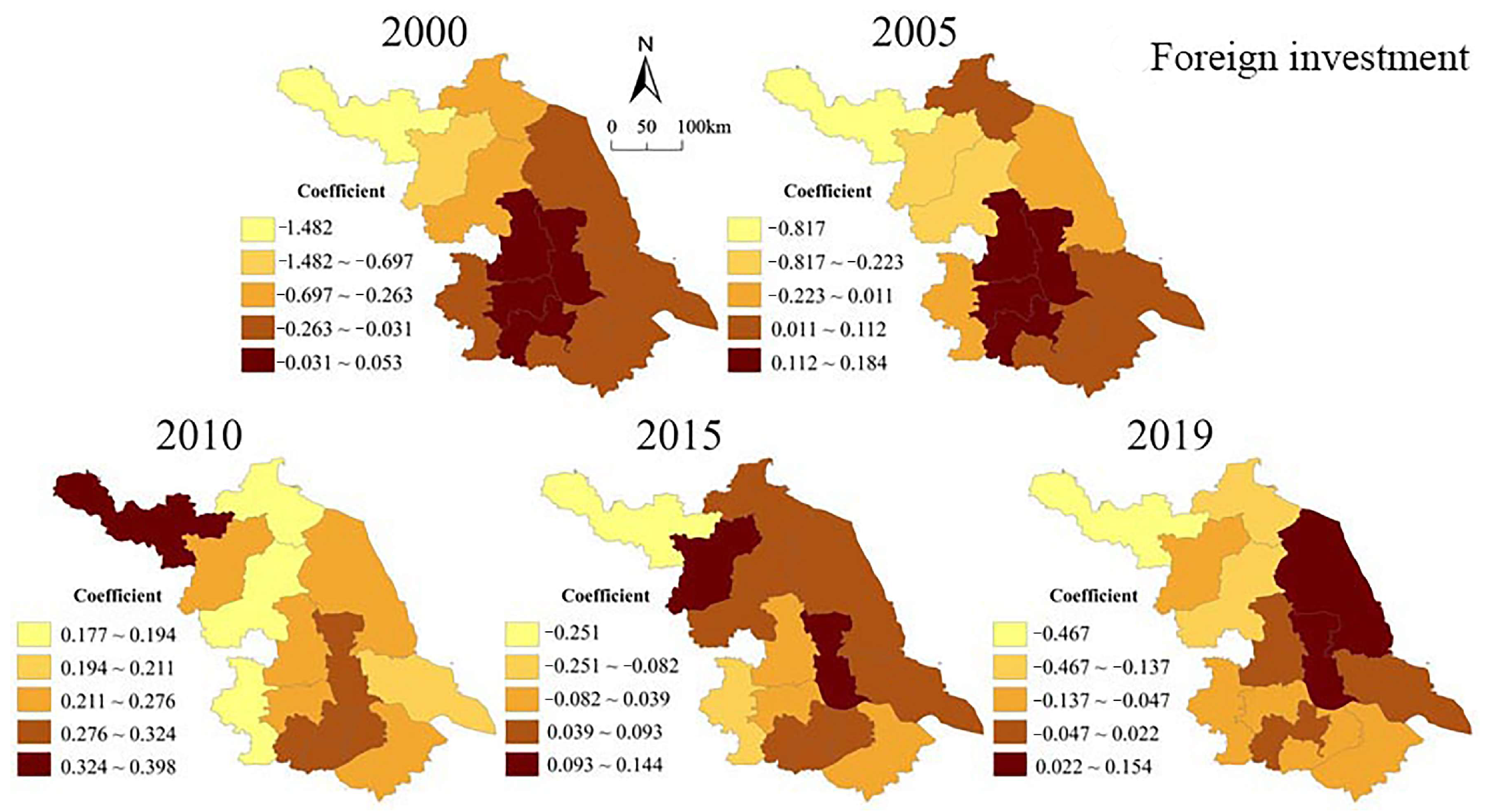

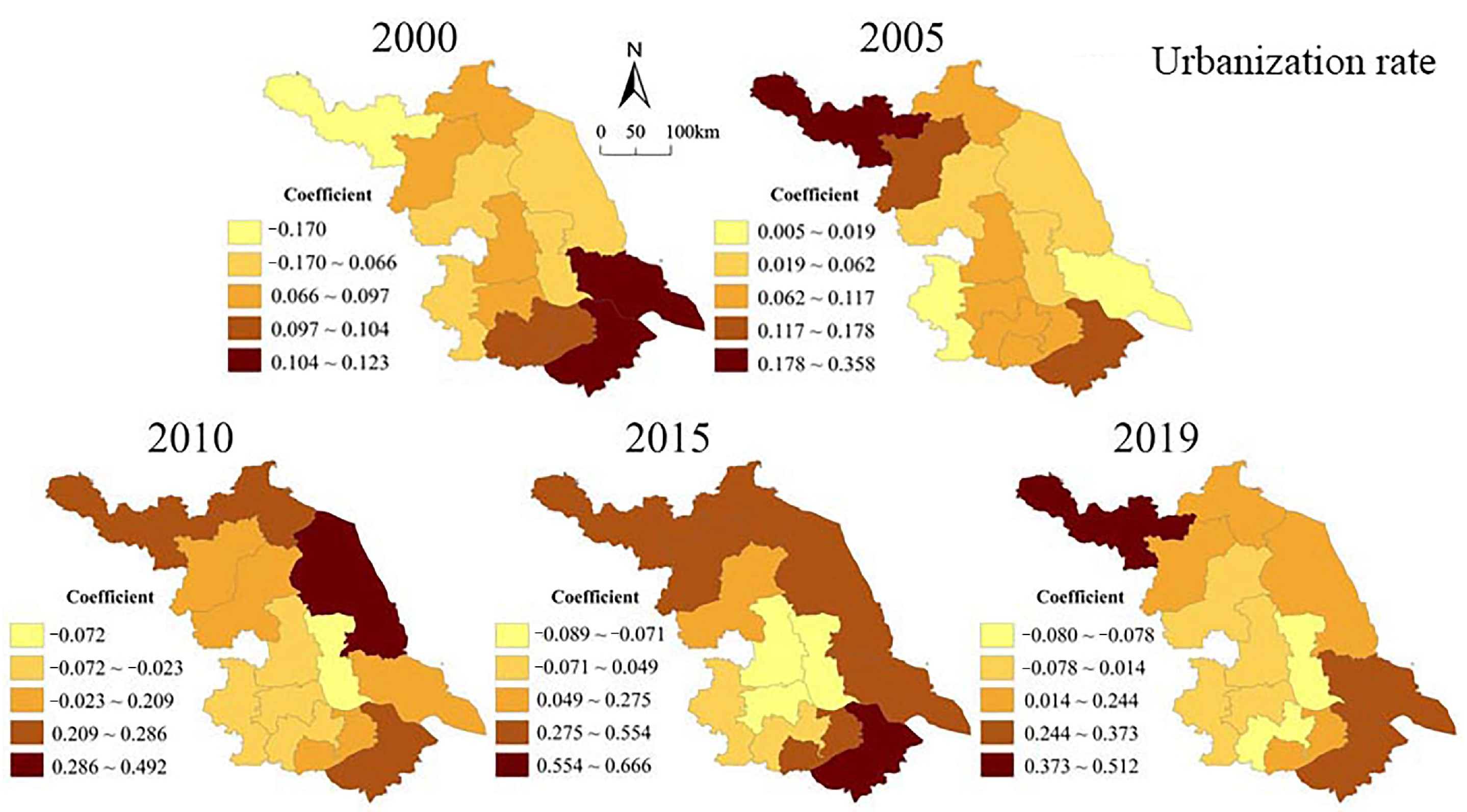
| Model | Fitting Function | a | b | c | R2 |
|---|---|---|---|---|---|
| Linear | y = ax + b | 6.064 | 100,313.024 | 0.887 | |
| Secondary | y = ax + bx2 + c | 0.0000272 | 3.971 | 123,719.627 | 0.894 |
| Power | y = axb | 1189.489 | 0.532 | 0.737 | |
| Index | y = aebx | 135,562.324 | 0.0000203 | 0.768 |
| Energy Type | Conversion Standard Coal Coefficient | Carbon-Emission Coefficient |
|---|---|---|
| Raw coal | 0.7143 t·t−1 | 0.7559 |
| Coke | 0.9714 t·t−1 | 0.8550 |
| Crude oil | 1.4286 t·t−1 | 0.5857 |
| Gasoline | 1.4714 t·t−1 | 0.5538 |
| Kerosene | 1.4714 t·t−1 | 0.5714 |
| Diesel oil | 1.4571 t·t−1 | 0.5921 |
| Fuel oil | 1.4286 t·t−1 | 0.6185 |
| Liquefied petroleum gas | 1.7143 t·t−1 | 0.5042 |
| Natural gas | 1.33 × 10−3 t·m−3 | 0.4483 |
| Year | Fitting Function | R2 |
|---|---|---|
| 2000–2003 | y = 55.047707x | 0.998 |
| 2004–2011 | y = 90.771864x | 0.991 |
| 2012–2019 | y = 84.182303x | 0.994 |
| Model | OLS | GWR | GTWR |
|---|---|---|---|
| R2 | 0.908 | 0.981 | 0.997 |
| Adjusted R2 | 0.901 | 0.980 | 0.996 |
| Sum of squared residuals | 0.879 | 0.184 | 0.034 |
| Sigma | / | 0.027 | 0.011 |
| AICc | −727.222 | −1034.620 | −1368.432 |
| Variable | Minimum | Maximum | Median | Mean |
|---|---|---|---|---|
| Constant term | −0.7513 | −0.0217 | −0.3235 | −0.3415 |
| Population size | 0.0769 | 0.7591 | 0.3657 | 0.4093 |
| Economic level | −0.1342 | 3.7711 | 0.5863 | 0.7473 |
| Industrial structure | −0.3525 | 0.4259 | 0.1147 | 0.0867 |
| Foreign investment | −1.4818 | 0.3986 | 0.0749 | 0.0314 |
| Energy intensity | −0.0448 | 3.6039 | 0.3690 | 0.6783 |
| Urbanization rate | −0.2268 | 0.7196 | 0.0957 | 0.1628 |
Disclaimer/Publisher’s Note: The statements, opinions and data contained in all publications are solely those of the individual author(s) and contributor(s) and not of MDPI and/or the editor(s). MDPI and/or the editor(s) disclaim responsibility for any injury to people or property resulting from any ideas, methods, instructions or products referred to in the content. |
© 2023 by the authors. Licensee MDPI, Basel, Switzerland. This article is an open access article distributed under the terms and conditions of the Creative Commons Attribution (CC BY) license (https://creativecommons.org/licenses/by/4.0/).
Share and Cite
Meng, H.; Zhang, X.; Du, X.; Du, K. Spatiotemporal Heterogeneity of the Characteristics and Influencing Factors of Energy-Consumption-Related Carbon Emissions in Jiangsu Province Based on DMSP-OLS and NPP-VIIRS. Land 2023, 12, 1369. https://doi.org/10.3390/land12071369
Meng H, Zhang X, Du X, Du K. Spatiotemporal Heterogeneity of the Characteristics and Influencing Factors of Energy-Consumption-Related Carbon Emissions in Jiangsu Province Based on DMSP-OLS and NPP-VIIRS. Land. 2023; 12(7):1369. https://doi.org/10.3390/land12071369
Chicago/Turabian StyleMeng, Hongzhi, Xiaoke Zhang, Xindong Du, and Kaiyuan Du. 2023. "Spatiotemporal Heterogeneity of the Characteristics and Influencing Factors of Energy-Consumption-Related Carbon Emissions in Jiangsu Province Based on DMSP-OLS and NPP-VIIRS" Land 12, no. 7: 1369. https://doi.org/10.3390/land12071369
APA StyleMeng, H., Zhang, X., Du, X., & Du, K. (2023). Spatiotemporal Heterogeneity of the Characteristics and Influencing Factors of Energy-Consumption-Related Carbon Emissions in Jiangsu Province Based on DMSP-OLS and NPP-VIIRS. Land, 12(7), 1369. https://doi.org/10.3390/land12071369





